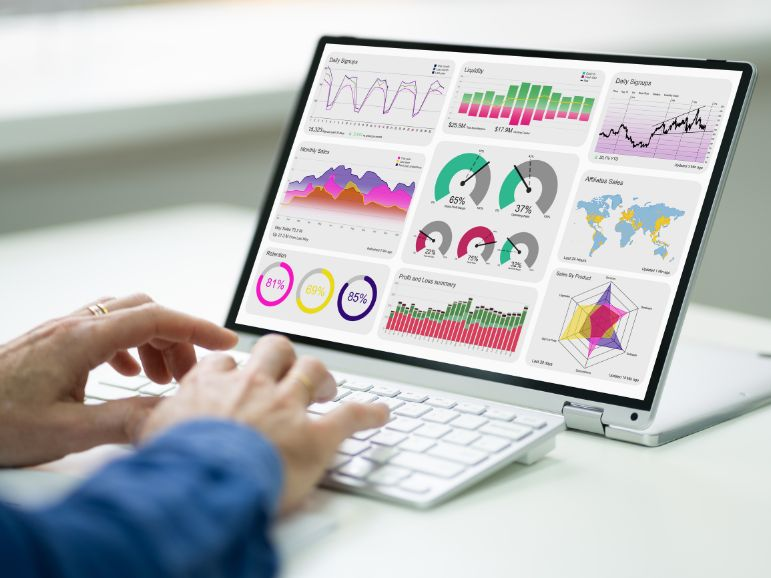BI – what does it mean?
Business Intelligence, or BI, is a field that deals with the collection, analysis and interpretation of data to support corporate decision-making processes.
In today’s world, where data is a key resource, Power BI, developed by Microsoft, is an extremely important tool. Power BI allows users to create interactive reports, data visualizations, and build advanced dashboards to instantly understand trends and key business metrics.
With its ease of use and ability to integrate with various data sources, Power BI enables companies to effectively manage data and make strategic decisions based on sound analysis. This tool is becoming increasingly indispensable in today’s business world, enabling companies to gain a competitive edge by better understanding their environment and responding faster to change.

Microsoft Power BI system – how is it built?
The architecture of the Microsoft BI system consists of:
- Desktop application (Power BI Desktop) – used for data processing, report building and presentation. This is the most extensive version of the program.
- Cloud application (Power BI Service) – which allows building reports and sharing them between users. This is a cloud-based version of the program that allows you to pull in data and work on it without installing software.
- Mobile application (Power BI App / Mobile) – allowing you to conveniently view reports and interact with them anywhere and anytime. This is the version of the program designed for phones and tablets.
Power BI – what are its applications?
Power BI is a business analytics software that enables users to efficiently create and share interactive reports based on company data. The finished report can be easily shared with all or selected team members. The system also has the advantage of its intuitive interface and drag-and-drop functionality, which makes it easy to create simple but professional-looking reports.
Power BI is a complete set of analytical tools that support the operations of companies and organizations in a variety of industries – from retail to manufacturing to healthcare. Microsoft’s product is used by such global companies as HP, Adobe, Pepsi and Toshiba, among others.

When is it worth implementing Business Intelligence class systems?
Business Intelligence class systems, including Power BI, are the answer to the needs of companies whose primary goal is to grow and strengthen their position in the market. In their case, analytical tools will be an invaluable support in the implementation of the adopted strategy.
The implementation of Power BI is recommended especially for those organizations where, despite the collection of data, no concrete conclusions are drawn from it. The software will help them see correlations between information and use it in planning business activities.
It is worth remembering the limited capabilities of the still widely used Excel. With large, cross-sourced data, analyzing and reporting it takes a lot of time and is subject to the risk of errors. A better choice in this case is modern business intelligence tools, for which analysis of this type of data, on top of that in real time, is not the slightest problem. Not insignificantly, Power BI enables the effective creation of attractive data visualizations and reports.

In which areas of the company’s business does Power BI benefit?
Power BI is widely used across disciplines and industries, enabling organizations to analyze data, generate reports and make better-informed decisions. Here are some of the main applications of Power BI:
Business Analysis
Microsoft Power BI enables companies to analyze financial, sales, operational and other data to help identify trends, forecast performance and optimize business processes.
Reporting and monitoring
With Power BI, users can create interactive reports and dashboards that allow them to monitor key performance indicators (KPIs) on an ongoing basis and respond quickly to changes in the organization.
Marketing analysis
Marketing agencies and corporate marketing departments can use Power BI to analyze the effectiveness of advertising campaigns, analyze customer behavior and forecast market trends.
Human resource analysis
Microsoft Power BI allows you to analyze data related to human resources, such as employee turnover, compensation analysis, and employee satisfaction analysis, which can help you optimize your HR strategy.

Analysis of financial data
The financial sector can use Power BI for investment data analysis, risk analysis, portfolio management and monitoring changes in financial markets.
Sales data analysis
Companies across industries can track sales data, analyze customer preferences, forecast product demand and optimize inventory management using Power BI.
Analysis of operational data
Manufacturing and logistics companies can analyze operational data, such as production times, raw material consumption, production costs and more, which helps optimize production and logistics processes.
Analysis of educational data
In the education sector, Microsoft Power BI can be used to analyze student performance, teacher evaluations, analyze attendance and monitor educational progress.
These applications are just a few examples of Power BI’s capabilities. Thanks to its versatility and ease of use, the tool can be tailored to the different needs and specifications of any industry or organization.
Microsoft Power BI implementation – stages
Implementing a Microsoft Power BI data analysis system is a multi-step process that requires careful analysis and planning. It can be presented in the following steps:
- Analysis of needs and goals:
- The first step in implementing Power BI is a thorough analysis of the organization’s needs and goals. This is the stage during which we define what specific benefits the company wants to achieve through the use of business intelligence tools.
- Data aggregation:
- In this stage, we focus on assessing the availability and quality of existing data. We identify if there are any deficiencies or inaccuracies, and prepare a plan to correct them. The value of analyses performed with the help of Power BI depends largely on the quality of the data, so the process of data aggregation and segmentation is extremely important.
- Designing the structure of reports and dashboards:
- Design is a key stage in which we define the structure of reports and dashboards. We consider what information is key for different users and how to present it in an understandable and useful way. Designing an intuitive interface ensures that employees use the tool effectively.

- Implementation:
- Once the structure of the reports is established, we move to the implementation stage. Power BI integration with existing systems and data import are key elements of this step. In addition, we configure security settings to ensure that access to data is properly controlled.
- User training:
- The introduction of a new tool requires robust user training. We organize training sessions to teach staff how to use the Power BI interface, interpret reports and effectively use data analysis functions.
- Monitoring and optimization:
- After implementation, the effectiveness of reports and dashboards should be systematically monitored. Analysis of user feedback data and regular optimizations of ETL processes keep system performance high. A proactive approach to monitoring and optimization is key to long-term success.

What benefits can be achieved in companies by implementing Microsoft Power BI?
Implementing Microsoft Power BI brings a number of benefits to companies, covering different areas of business. Key among them are:
Improved data analysis
Power BI allows you to collect, analyze and visualize data in real time. This allows companies to understand their data more quickly and accurately, leading to more relevant analysis and business decisions.
Intuitive reporting
The platform offers an intuitive interface for creating reports and dashboards. This makes it easy for even people without technical expertise to generate clear and attractive reports, speeding up the decision-making process.
Easy integration with other tools
Power BI integrates with many other tools and platforms, such as Microsoft Excel, SharePoint and Azure. This facilitates the use of existing resources and ensures seamless collaboration between different systems.

Data centralization
With Power BI, data from different sources can be combined and processed in one place. This eliminates the need for multiple data analysis tools and simplifies information management.
Quick response to changes
Dynamic reporting and real-time analysis allow companies to respond quickly to changing market conditions. This is crucial, especially in today’s dynamic business environment.
Increase operational efficiency
Microsoft Power BI automates many data analysis processes, saving time and resources. Companies can focus on essential tasks rather than manual data processing.
Improving organizational transparency
With access to real data at various organizational levels, all employees have a more complete picture of the company’s situation. This, in turn, fosters a better understanding of the goals and joint efforts to achieve them.

Implementing Microsoft Power BI – tailor-made solutions
Are you planning to implement Power BI in your company? Modern analytical tools are a great convenience for companies looking to efficiently manage their own data. However, in order for them to do their job, they need to be perfectly tailored to the needs and expectations of the organization in question. At EBIS, we implement Microsoft BI products based on a customized offer prepared for a given client.


